A Wader Spectacular today, up on the Wash. It was a rather cloudy start, but brightened up nicely from mid-morning. It was warm in the afternoon, particularly out of the brisk SW breeze.
It was an early start, to get up to the Wash in time to watch the waders gathering ahead of the big high tide today. As we met in Wells first thing, we could hear Pink-footed Geese calling high overhead. They have just started to return in the last couple of days, early this year, coming back from Iceland to spend the winter here. A reminder that Autumn is upon us!
When we got up onto the seawall, we were in good time and there was still lots of exposed mud but the tide coming in fast. We trained the scope on the small groups of Knot and Bar-tailed Godwits already gathering on the edge of the rising water. A large roost of Oystercatcher asleep away to our right, on the shore, would soon have to move, as the mud would shortly be under water.
Small groups of Ringed Plover were flying in along the near shore, stopping to feed on the still exposed mud. Several Turnstones and one or two Dunlin were in with them. A colour-ringed Curlew dropped in too, but was probably ringed locally and by the looks of its shiny leg flag, quite recently!
It was not long before the mud in front of us was covered with water, so we moved further down towards the hides. All the Oystercatchers were flying further up, from where they had been trying to roost earlier, and had gathered again in a vast slick spread out across the mud out in the middle. A large flock of Knot gathered nearby looked like a patch of darker grey mud at a distance, until you looked more closely and could see it was actually a mass of birds packed tightly together.

The official WeBS count of the Knot here had been conducted just a couple of days ago – 67,000! We were not up to this number yet, with many birds still on the mud further round on the Wash. As the tide continued to rise, they started to get restless, flying up and swirling round in huge flocks, before spiralling in to join the birds already gathered down closer to us.
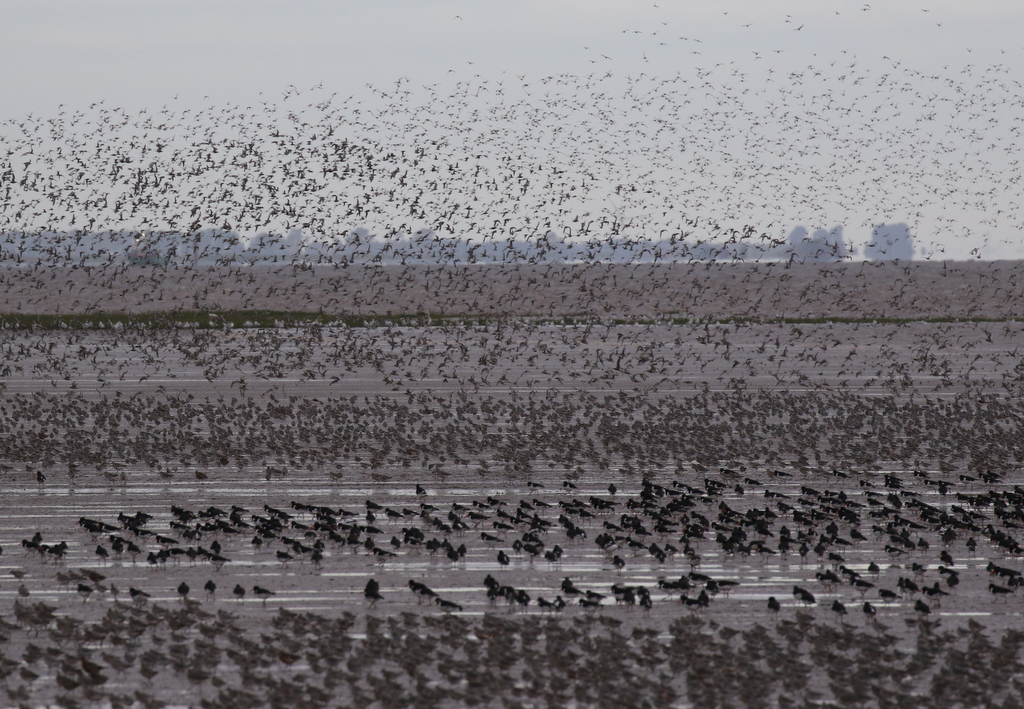
As we got down to the corner, opposite the saltmarsh, the water was still coming in fast. Those birds on the shore were getting pushed ever higher, walking away from the rising tide. It looked like the flock was flowing too, Oystercatchers, Knot and Godwits.
As the mass of birds became increasingly concentrated into the top corner, where the last remaining exposed mud was to be found, the Oystercatchers started peeling off first, heading past us in lines into the pits, piping noisily. The Knot waited longer, reluctant to leave the safety of the mud, until they were packed tightly into the last remaining arc of mud, right up against the saltmarsh. Finally they took off, tens of thousands of them rising together. Amazing to watch.

Some large groups of Knot flew in past us, thousands at a time, low overhead. We watched them circling round and dropping down onto the pit behind us. Thousands more climbed higher and higher into the sky. There was nowhere left to roost out on the Wash now, with the tide in, and it seemed likely that the islands on the pit may have been already full, so they didn’t know where to go to roost. They spent ages flying backwards and forwards, getting ever higher.

There were still tens of thousands of Knot in the sky. It was very impressive to watch, and we stood and marvelled at them. The flocks were stacked, some higher, some lower, crissing and crossing backwards and forwards over and above each other. We stood and watched them for a while, mesmerised.
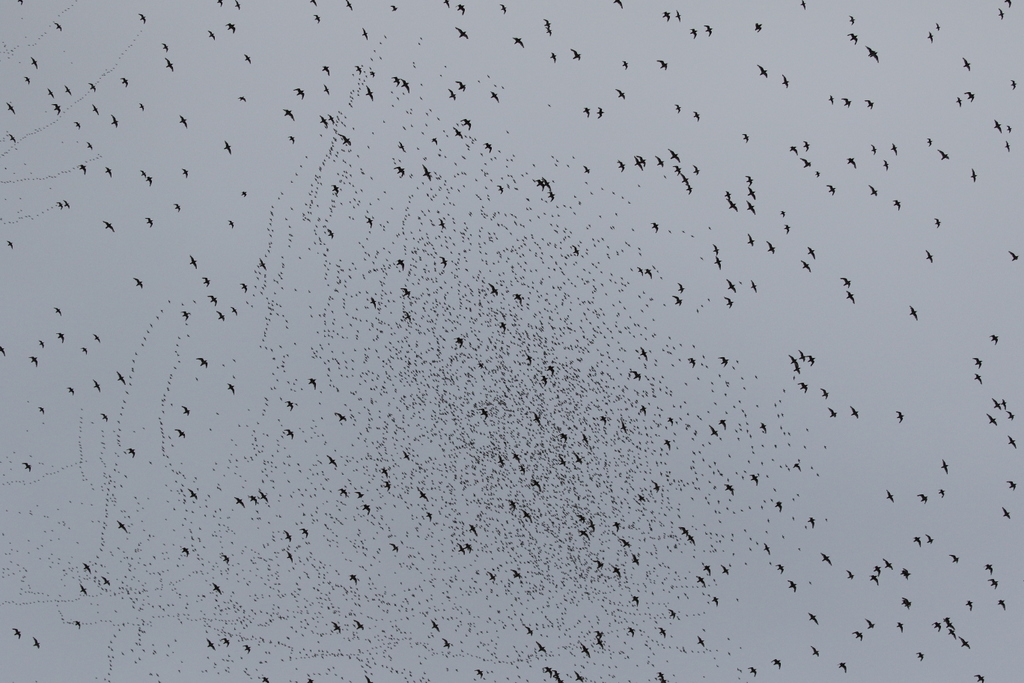
The Knot showed no signs of coming down, although some seemed to drift away out over the Wash. We decided to head round to South Hide, to see what we could find on the roosting on the pit. One or two Yellow Wagtails flew back and forth over the grass calling shrilly, and a couple of Common Sandpipers flew past over the edge of the wash, with their distinctive bowed wings and flicking wingbeats.
There were lots of waders on the pits. The Oystercatchers were mostly on the banks either side. Quite a few Knot were packed onto some of the closer islands, though we could see thousands more further down the pit. Some Knot were roosting in the water towards the front, where we could get a closer look at them in the scope. A little group of sleeping Dunlin on the nearest bank included a couple of adults with black belly patches and several juveniles with spotted bellies.
There were more Black-tailed Godwits roosting on the pit than we had seen out on the Wash, mostly now in drab grey-brown non-breeding plumage. A single Bar-tailed Godwit was standing on the bank in front of the Oystercatchers and it gave us a nice opportunity to compare the two species in the scope. Most of the Bar-tailed Godwits seemed to be roosting out on the saltmarsh with all the Curlew.
Three Spoonbills were scattered separately around the shore of the pit, one roosting with the Little Egrets but the others roosting with the waders. One was awake when we first arrived, but typically they all spent most of the time asleep. That is what Spoonbills seem to do most of the time!
Heading back round to Shore Hide, there were lots of Linnets and Reed Buntings in the suaeda bushes, pushed up off the shore by the tide. We could still see a couple of flocks of Knot flying high over the Wash. The islands at the other end of the pit were already packed tight with Knot, standing shoulder to shoulder, and it looked like there was no room for any more. Apart from on the edge of one of the nearest islands, closest to the bank, which the Knot seemed to shun and was occupied by more Dunlin instead.

There were lots of Common Redshanks roosting along the far shore of the pit, opposite the hide. The rocks in the middle seemed to have been commandeered by Cormorants and Greylag Geese. However, looking carefully in amongst the geese, we found several Spotted Redshanks. They were fast asleep, head on to us, but we could still pick them out, slightly paler, whiter fronted than the Common Redshanks. One Spotted Redshank woke up and started preening while we had the scope on it, flashing its distinctive longer, needle-fine-tipped bill.
The Knot were now starting to get restless. We walked back over to the edge of the Wash, but on such a big tide as it was today the mud was still only just starting to reappear. Small lines of Knot started streaming off from the pit, over the Bank next to us. They came over a few hundred at a time at first, but there was nowhere for them to go, and they whirled around low out over the Wash. The Oystercatchers started to gather in the corner first, with their longer legs. But the tide was going out fast now and gradually more and more was mud exposed.
Then huge waves of Knot started to come up off the pit, streaming back out to the Wash. The flew low over the bank, and skimmed the surface of the water as they headed back out to where the mud was now appearing again.
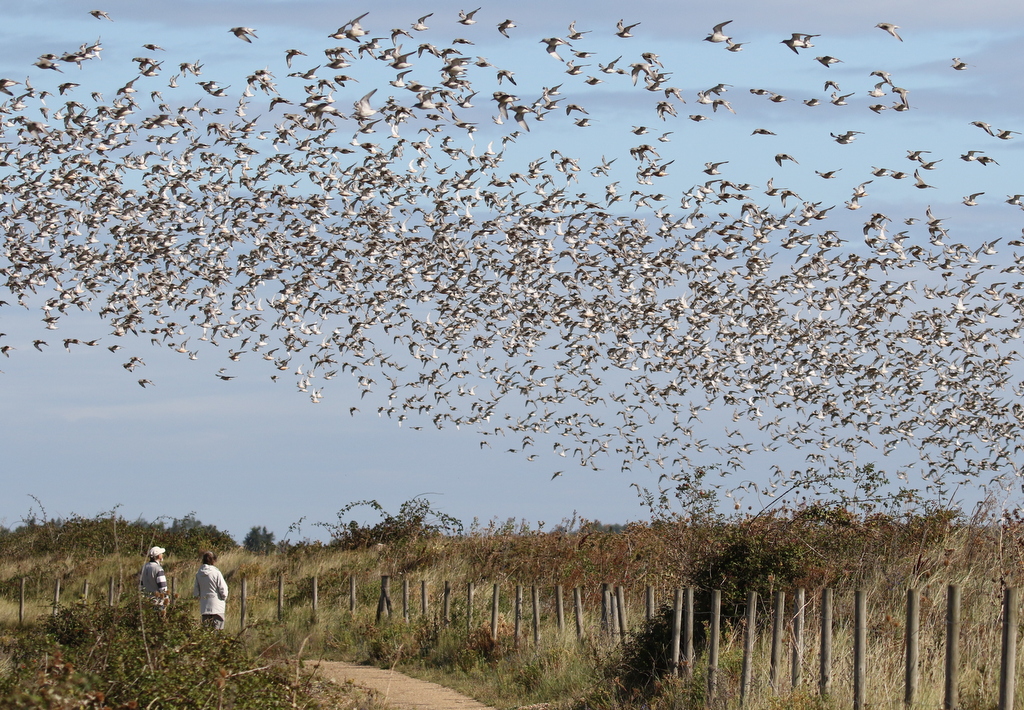
One large flock of Knot, probably a thousand or more strong, came right over our heads. They were so low, all we could hear was the beating of a thousand pairs of wings. Amazing!
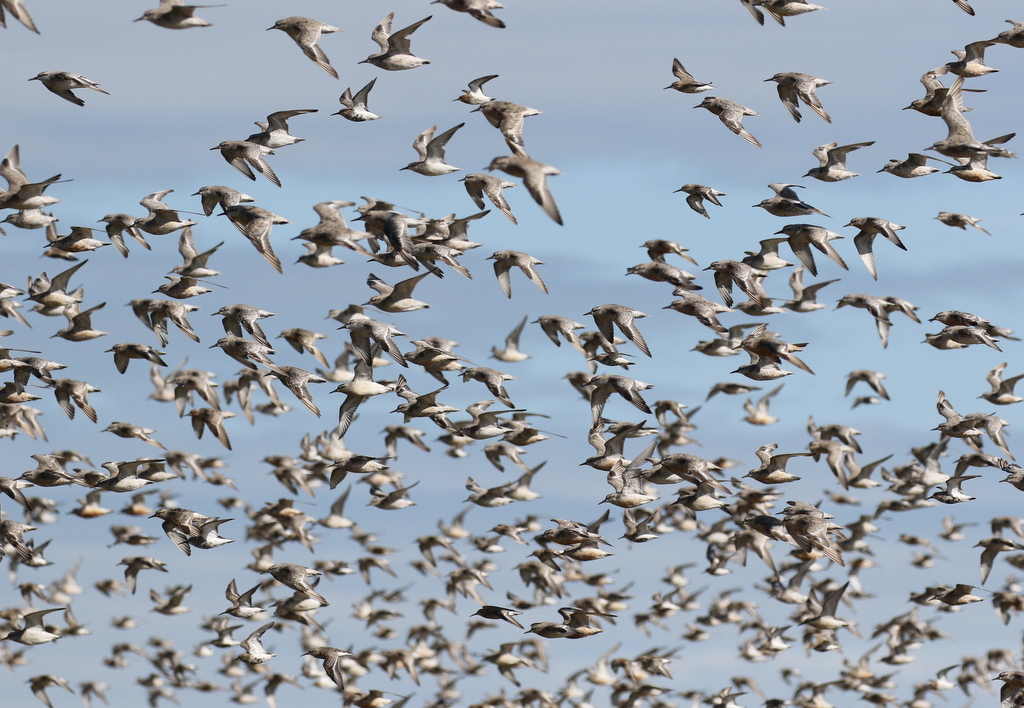
We turned our attention back out to the growing throngs gathering out on the mud. A small group of Grey Plover flew in from elsewhere, possibly having roosted on the saltmarsh, and landed in front of the flocks. Through the scope we could see their black faces and bellies, still in breeding plumage. Nine Sanderling dropped in too, and started feeding busily on the wet mud.
The pit had largely emptied of waders now, so we decided to move on and walked back to the minibus. A small roost of gulls had gathered on one of the other pits, mostly Black-headed Gulls and a few Common Gulls, but stopping to look through them briefly we found three Mediterranean Gulls in with them too. Two adults preening on the shore, white winged and with a brighter red bill and black bandit mask.
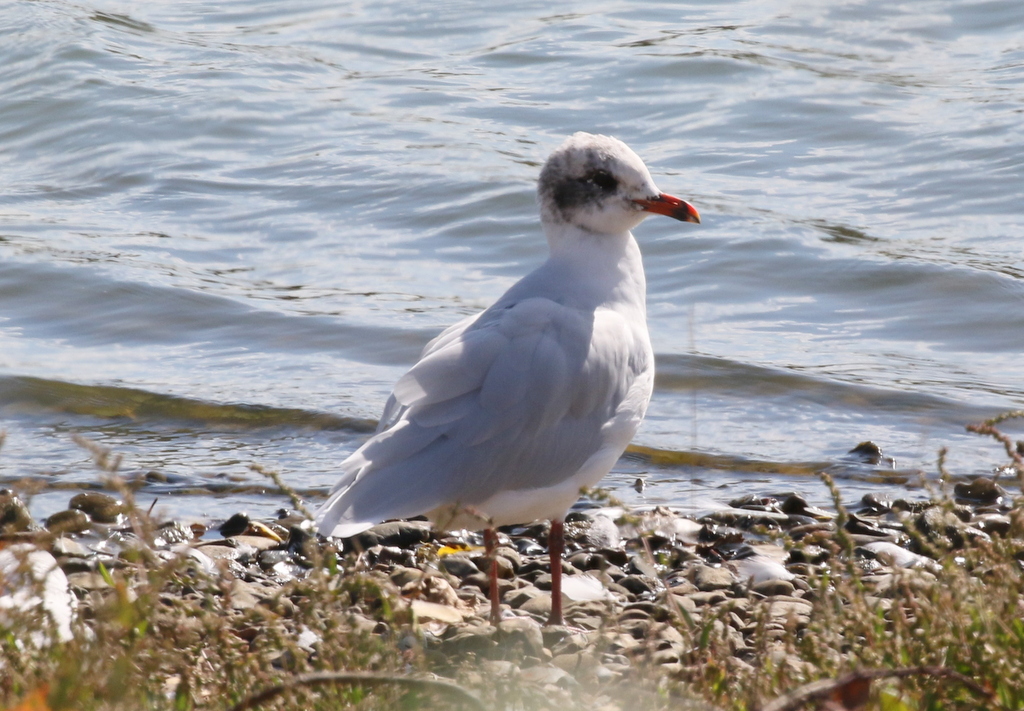
After a quick break for coffee, we headed round the coast to Titchwell. After our early start this morning, we decided to break for an early lunch by the Visitor Centre. Then after lunch, we headed out to explore the reserve.
As we walked up along the main West Bank path beside the reedbed, we could hear Bearded Tits calling. It was quite breezy now and the reeds were swaying in the wind, but despite that, two appeared up in the reeds in a sheltered spot. We had a good view of a male and a female together, before they dropped down out of view.
We would have been happy with that, but we hadn’t gone much further, when we heard more Bearded Tits calling on the other side of the bank. We poked our heads over and spotted two cracking males perched nicely in the tops of the reeds there, with powder blue heads and black droopy moustaches. When they eventually flew, more birds came up from hidden in the reeds and they all zipped across the path and dropped back down into the edge of the main reedbed. They spent several minutes feeding around the small pools on that side, low round the edge of the water or climbing up into the tops calling, before they eventually flew further back and disappeared.

The Reedbed Pool held just a few ducks, Gadwall, Tufted Duck and Common Pochard. So we continued on to Island Hide to have a look at the Freshmarsh.
There were lots of waders scattered out over the mud here too. Lots of Ruff and a good number of Avocets still. A smart Lapwing was feeding close to the hide, its iridescent plumage shining green, bronze and purple in the afternoon sunshine. A couple of juvenile Curlew Sandpipers were in with the Dunlin, larger, longer billed and cleaner white below. A single juvenile Little Ringed Plover was running round with several Ringed Plovers over by the reeds. Through the scope, we could see the ghosting of the eye ring which is brighter golden yellow on breeding adults.
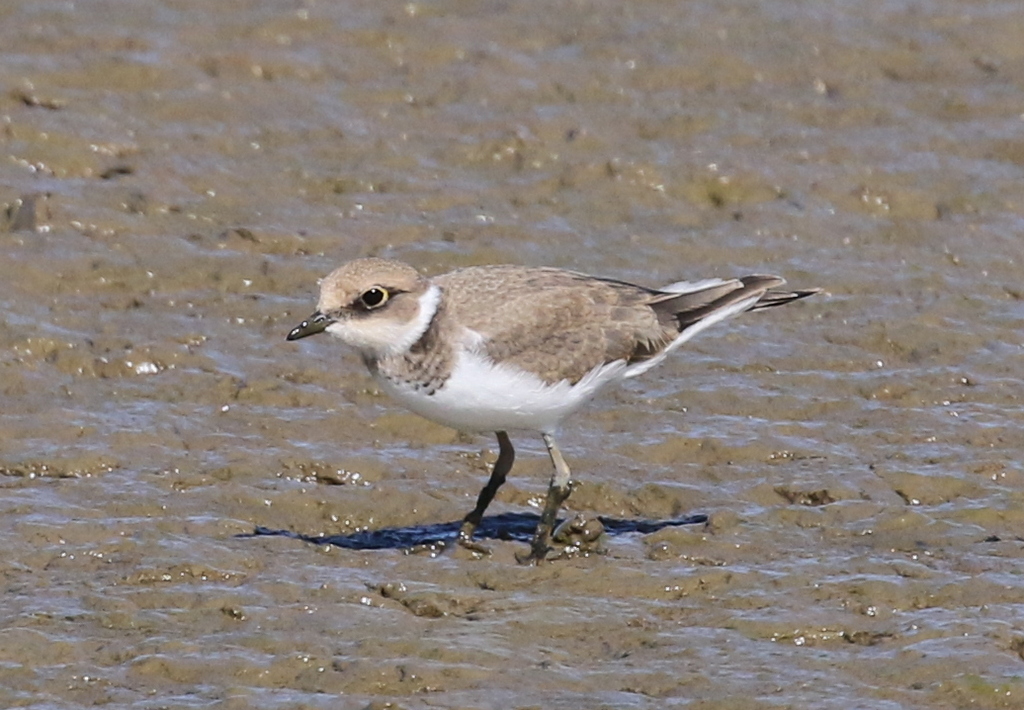
A Spoonbill flew in from the direction of the sea, but there were no others on the Freshmarsh this afternoon, so after a quick look it carried on through. A Water Rail appeared on the edge of the reeds. It disappeared quickly back in, but thankfully reappeared again a short while later and this time spent some time preening out in the open on the mud. A couple more Bearded Tits, tawny brown juveniles, appeared on the mud in front of the reeds too and a single Common Snipe was feeding nearby.
A lone Knot, odd to see on its own after the flocks of thousands this morning, was rather distant at first. But then it flew straight in to the hide and started feeding in the cut reeds just below the window, giving us stunning close views. It was a juvenile, most likely here from Greenland or Canada where it had been raised over the summer, and had probably never seen people before so didn’t know to be afraid.

Back out on the main path, we couldn’t see anything over by Parrinder Hide, so we carried straight on towards the beach for a quick look at the sea. The tide was out, and their were lots of waders down on the mussel beds, Black-tailed and Bar-tailed Godwits, Curlew, Redshanks and Turnstones. A Sandwich Tern flew past offshore and we spotted two or three Great Crested Grebes out on the sea.
Unfortunately, it was time to head back now – after an early start, we had an early finish this afternoon. Two Greenshanks calling out over the saltmarsh as we walked back, flew in over the path behind us. A nice last addition to our wader list for the day, and a good point to finish on.
















